American actor James Dean (1931-1955) was the quintessential 1950s teenager, brooding and romantic but he is also a gay icon. An air of androgyny attributed to his iconic appeal to both men and women. The three roles that defined his stardom are as troubled teenager Jim Stark in Rebel Without a Cause (1955), loner Cal Trask in East of Eden (1955) and surly ranch hand Jett Rink in Giant (1956). After he died in a car crash, the only 24-year-old Dean became the first actor to receive a posthumous Academy Award nomination for Best Actor.
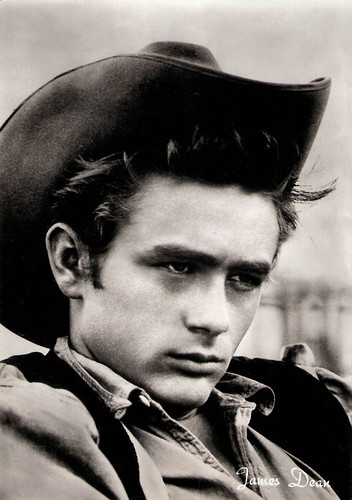
Italian postcard by Rotalfoto, Milano, no. 519. Photo: Richard Miller / Warner Bros. Publicity still for Giant (George Stevens, 1956).
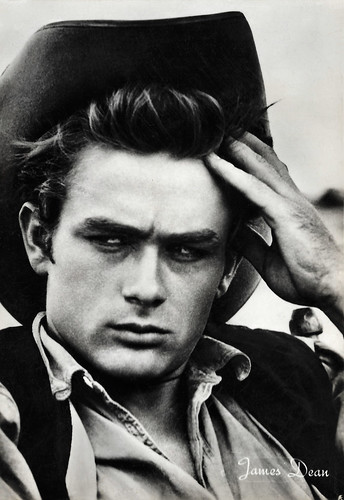
Italian postcard by Rotalfoto, Milano, no. 522. Photo: Richard Miller / Warner Bros. Publicity still for Giant (George Stevens, 1956).
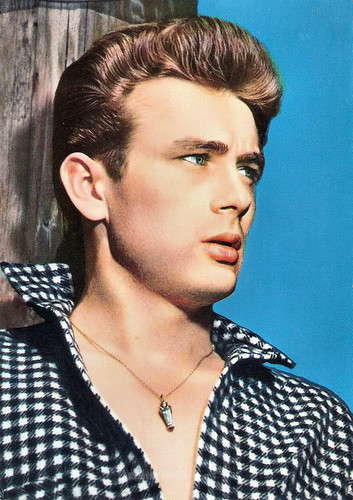
French postcard by Editions P.I., offered by Les Carbones Korès 'Carboplane', no. 18. Photo: AFEX, Wien (Vienna). Photo: publicity still for East of Eden (Elia Kazan, 1955).
James Byron Dean was born in 1931, in Marion, Indiana, the only child of Winton Dean and Mildred Marie Wilson. Six years after his father had left farming to become a dental technician, Dean and his family moved to Santa Monica, California. In 1938, his mother was suddenly struck with acute stomach pain and quickly began to lose weight. She died of uterine cancer when Dean was nine years old. Unable to care for his son, Dean's father sent him to live with his aunt and uncle, Ortense and Marcus Winslow, on their farm in Fairmount, Indiana, where he was raised in their Quaker household. Dean's overall performance in school was exceptional and he was a popular student. He played on the baseball and varsity basketball teams, studied drama, and competed in public speaking through the Indiana High School Forensic Association.
After graduating from Fairmount High School in May 1949, he moved back to California with his dog, Max, to live with his father and stepmother. He enrolled in Santa Monica College (SMC) and majored in pre-law. He transferred to UCLA for one semester and changed his major to drama, which resulted in estrangement from his father. While at UCLA, Dean was picked from a group of 350 actors to portray Malcolm in 'Macbeth'. At that time, he also began acting in James Whitmore's workshop. In January 1951, he dropped out of UCLA to pursue a full-time career as an actor.
Dean's first television appearance was in a Pepsi-Cola commercial. His first speaking part was as John the Beloved Disciple, in Hill Number One (1951), an Easter television special dramatising the Resurrection of Jesus. Dean subsequently obtained three walk-on roles in films: as a soldier in Samuel Fuller’s moody study of a platoon in the Korean War, Fixed Bayonets! (Samuel Fuller, 1951), a boxing cornerman in the Dean Martin and Jerry Lewis comedy Sailor Beware (Hal Walker, 1952), and a youth in the comedy Has Anybody Seen My Gal? (Douglas Sirk, 1952) with Rock Hudson.
While struggling to get jobs in Hollywood, Dean also worked as a parking lot attendant at CBS Studios. During that time, he met Rogers Brackett, a radio director for an advertising agency, who offered him professional help and guidance in his chosen career, as well as a place to stay. In July 1951, Dean appeared on Alias Jane Doe, which was produced by Brackett. In October 1951, Dean moved to New York City. There, he worked as a stunt tester for the game show Beat the Clock, but was subsequently fired for allegedly performing the tasks too quickly. He also appeared in episodes of several CBS television series like The Web, Studio One, and Lux Video Theatre, before gaining admission to the Actors Studio to study method acting under Lee Strasberg. There, he was classmates and close friends with Carroll Baker, alongside whom he would eventually star in Giant (George Stevens, 1956).
Dean's career picked up and he performed in further episodes of several early 1950s television. One early role, for the CBS series Omnibus in the episode Glory in the Flower (1953), saw Dean portraying the type of disaffected youth he would later portray in Rebel Without a Cause. In 1954, Dean had his breakthrough on Broadway in a play written by Augustus and Ruth Goetz and based on André Gide's book 'The Immoralist'. Louis Jourdan played Michel, a gay archaeologist who marries partly in the hope of curbing his homosexual instincts. He is unable to consummate the marriage so the pair travel from Normandy to Algeria for a honeymoon, hoping that will kindle some romance. The husband is seduced by Bachir, their Arab houseboy (James Dean), but this allows him to sleep with his wife (Geraldine Page), who falls pregnant. Positive reviews for Dean's role led to calls from Hollywood.

Dutch postcard by Uitg. Takken, Utrecht, no. 3685. Photo: Warner Bros. Dean photographed by Roy Schatt at Christmas 1954.
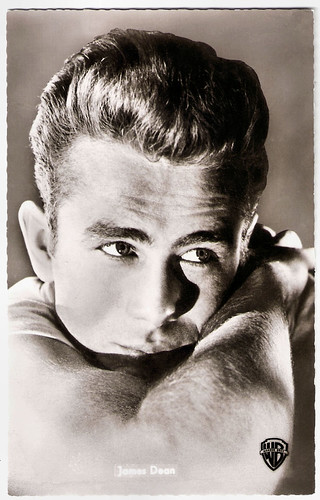
German postcard by Kolibri-Verlag G.m.b.H., no. 1983. Photo: Warner Bros.
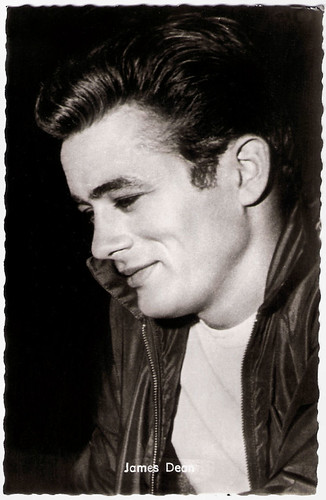
German postcard by Kolibri-Verlag G.m.b.H., no. 2714. Photo: publicity still for Rebel Without a Cause (Nicholas Ray, 1955).
In 1954, James Dean was cast in the emotionally complex role of Cal Trask in East of Eden (Elia Kazan, 1955), an adaptation of John Steinbeck's 1952 novel East of Eden. The lengthy novel deals with the story of the Trask and Hamilton families throughout three generations, focusing especially on the lives of the latter two generations in Salinas Valley, California, from the mid-19th century through the 1910s.
In contrast to the book, the film script focused on the last portion of the story, predominantly with the character of Cal. Though he initially seems more aloof and emotionally troubled than his twin brother Aron (Richard Davalos), Cal is soon seen to be more worldly, business savvy, and even sagacious than their pious and constantly disapproving father (Raymond Massey) who seeks to invent a vegetable refrigeration process. Cal is bothered by the mystery of their supposedly dead mother, and discovers she is still alive and a brothel-keeping 'madam'; the part was played by actress Jo Van Fleet.
Much of Dean's performance in the film was unscripted, including his dance in the bean field and his foetal-like posturing while riding on top of a train boxcar (after searching out his mother in nearby Monterey). The most famous improvisation of the film occurs when Cal's father rejects his gift of $5,000, money Cal earned by speculating in beans before the US became involved in World War I. Instead of running away from his father as the script called for, Dean instinctively turned to Massey and in a gesture of extreme emotion, lunged forward and grabbed him in a full embrace, crying. Kazan kept this and Massey's shocked reaction in the film.
Wikipedia: “Dean's performance in the film foreshadowed his role as Jim Stark in Rebel Without A Cause. Both characters are angst-ridden protagonists and misunderstood outcasts, desperately craving approval from their fathers.”
In recognition of his performance in East of Eden, Dean was nominated posthumously for the 1956 Academy Awards as Best Actor in a Leading Role of 1955, the first official posthumous acting nomination in Academy Awards history. East of Eden was the only film starring Dean that he would see released in his lifetime.

British postcard in the Picturegoer Series, London, no. D 697. Photo: Warner. Publicity still for East of Eden (Elia Kazan, 1955).

British postcard in the Picturegoer Series, no. D 780. Photo: Warner Bros. Julie Harris and James Dean in East of Eden (Elia Kazan, 1955). Collection: Marlene Pilaete.
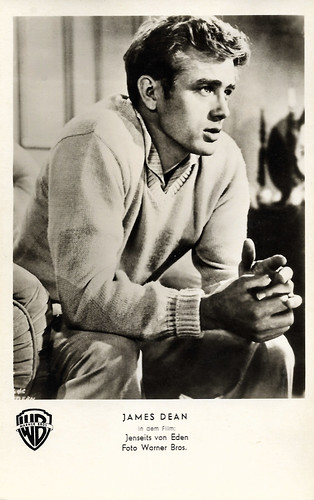
German postcard by Kunst und Bild, Berlin, no. V 370. Photo: Warner Bros. Publicity still for East of Eden (Elia Kazan, 1955).
James Dean quickly followed up his role in Eden with a starring role as the brooding red-jacketed teenager Jim Stark in Rebel Without a Cause (Nicholas Ray, 1955) with Sal Mineo and Natalie Wood. The film depicts the dilemma of a typical teenager of the time, who feels that no one, not even his peers, can understand him. The film scrupulously follows the classic theatrical disciplines, telling all within 24 hours.
Jim Stark was Dean’s true starring role and Rebel Without a Cause proved to be hugely popular among teenagers. The landmark juvenile-delinquent drama fixed James Dean’s image forever in American culture.
In his next film, Giant (George Stevens, 1956), Dean played a supporting role to Elizabeth Taylor and Rock Hudson. This was due to his desire to avoid being typecast as a rebellious teenager like Cal Trask or Jim Stark. In the film, he plays Jett Rink, a Texan ranch hand who strikes oil and becomes wealthy. His role was notable in that, to portray an older version of his character in the film's later scenes, Dean dyed his hair grey and shaved some of it off to give himself a receding hairline.
Giant would prove to be Dean's last film. At the end of the film, Dean is supposed to make a drunken speech at a banquet; this is nicknamed the 'Last Supper' because it was the last scene before his sudden death. Due to his desire to make the scene more realistic by actually being inebriated for the take, Dean mumbled so much that director George Stevens decided the scene had to be overdubbed.
This was done by Nick Adams, who had a small role in the film because Dean had died before the film was edited. Dean received his second posthumous Best Actor Academy Award nomination for his role in Giant at the 29th Academy Awards in 1957 for films released in 1956.
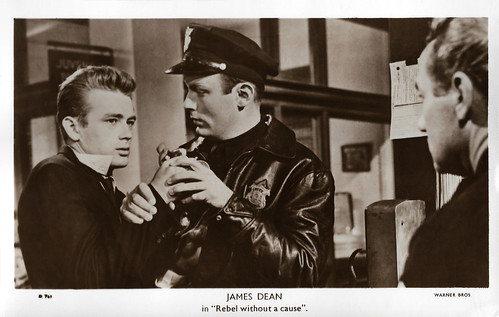
British postcard in the Picturegoer Series, London, no. D 769. Photo: Warner Bros. Publicity still for Rebel Without a Cause (Nicholas Ray, 1955).

British postcard in the Picturegoer Series, London, no. D 770. Photo: Warner Bros. Publicity still for Rebel Without a Cause (Nicholas Ray, 1955) with Sal Mineo.
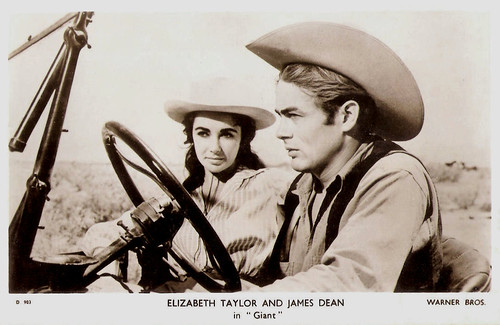
British postcard in the Picturegoer Series, London, no. D 903. Photo: Warner Bros. Publicity still for Giant (George Stevens, 1956) with Elizabeth Taylor.

British postcard in the Picturegoer Series, no. D 905. Photo: Warner Bros. Carroll Baker and James Dean in Giant (William Wyler, 1958).
Today, James Dean is often considered an icon because of his perceived experimental take on life, which included his ambivalent sexuality. Most of his so-called affairs with various starlets were made up by the Warner Brothers' public relations. Dean's best-remembered relationship was with young Italian actress Pier Angeli, whom he met while Angeli was shooting The Silver Chalice (Victor Saville, 1954) on an adjoining Warner lot, and with whom he exchanged items of jewellery as love tokens.
Angeli's Catholic mother disapproved of Dean. After finishing his role for East of Eden, he took a brief trip to New York in October 1954. While he was away, Angeli unexpectedly announced her engagement to Italian-American singer Vic Damone. The press was shocked and Dean expressed his irritation. Angeli married Damone the following month. Dean also dated Swiss actress Ursula Andress. She was seen with Dean in his sports car and was with him on the day he bought the car that he died in.
A Gay Times Readers' Awards cited him as 'the greatest male gay icon of all time' and other gay media also mention him as an icon. Dean’s ambiguous relationship with Sal Mineo in the angst-ridden Rebel Without A Cause has led many to speculate and view this golden-age film as years ahead of its time. When questioned about his sexual orientation, Dean is reported to have said, "No, I am not a homosexual. But I'm also not going to go through life with one hand tied behind my back." Dean, with time on his side during down times of filming, often frequented gay bars in mornings, afternoons and evenings in both Hollywood, Studio City and North Hollywood.
Dean and screenwriter and theatre student from UCLA, William Bast lived together as roommates for several years. Bast later became Dean's first biographer and said he and Dean ‘experimented’ sexually. Another biographer, journalist Joe Hyams suggests that any gay activity Dean might have been involved in appears to have been strictly "for trade", as a means of advancing his career. However, the ‘trade only’ notion is contradicted by Bast and other Dean biographers. Biographer Val Holley: “There's been quite an evolution in the thinking since Dean died in 1955, moving from ‘James Dean was straight’ to ‘Dean had sex with men but only to advance his career’ to ‘Dean had sex with women but only to advance his career.’
In 2016, a new gossipy biography was published, James Dean: Tomorrow Never Comes, by Darwin Porter and Danforth Prince. The authors claim Dean was in love with Marlon Brando and the two would have had a long sexual affair with S&M overtones. We probably may never know for certain if Dean identified as gay, straight, or bisexual, but, regardless, of what he’s come to represent he still resonates with many LGBTQ audiences. When questioned about Dean's sexuality by the openly gay journalist Kevin Sessums for POZ magazine, Elizabeth Taylor responded, "He hadn't made up his mind. He was only 24 when he died. But he was certainly fascinated by women. He flirted around. He and I … twinkled."

With Pier Angeli. German postcard by Kolibri-Verlag, Minden/Westf., no. 2346. Photo: Keystone.
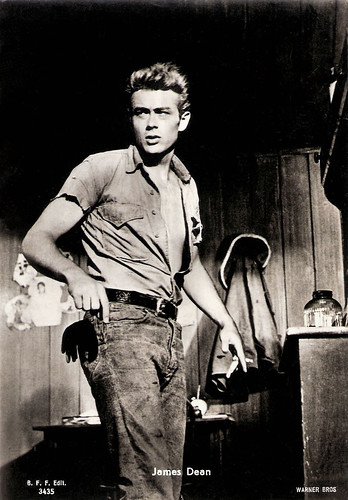
Italian postcard by B.F.F. Edit., Firenze (Florence), no. 3435. Photo: Warner Bros. Publicity still for Giant (George Stevens, 1956).
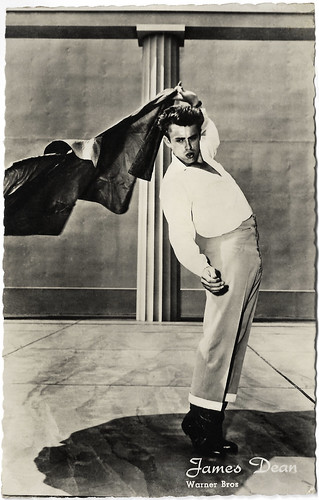
Dutch postcard. Photo: Warner Bros.
In 1954, James Dean became interested in developing an auto racing career. He purchased various vehicles after filming for East of Eden had concluded, including a Triumph Tiger T110 and a Porsche 356. Just before filming began on Rebel Without a Cause, he competed in his first professional event at the Palm Springs Road Races, which was held in Palm Springs, California on March 26–27, 1955. Dean achieved first place in the novice class and second place at the main event.
His racing continued in Bakersfield a month later, where he finished first in his class and third overall. Dean hoped to compete in the Indianapolis 500, but his busy schedule made it impossible. Dean's final race occurred in Santa Barbara on Memorial Day, 30 May 1955. He was unable to finish the competition due to a blown piston. His brief racing career was put on hold when Warner Brothers barred him from all racing during the production of Giant. Dean had finished shooting his scenes and the movie was in post-production when he decided to race again.
Dean was scheduled to compete at a racing event in Salinas, California on 30 September 1955. Accompanying the actor to the occasion was stunt coordinator Bill Hickman, Collier's photographer Sanford Roth, and Rolf Wütherich, the German mechanic from the Porsche factory who maintained Dean's Porsche 550 Spyder 'Little Bastard' car. Wütherich, who had encouraged Dean to drive the car from Los Angeles to Salinas to break it in, accompanied Dean in the Porsche. At 3:30 p.m. Dean was ticketed for speeding, as was Hickman who was following behind in another car.
As the group travelled to the event via U.S. Route 466, (currently SR 46) at approximately 5:15 p.m. a 1950 Ford Tudor was passing through an intersection while turning, ahead of the Porsche. Dean, unable to stop in time, slammed into the driver's side of the Ford resulting in Dean's car bouncing across the pavement onto the side of the highway. Dean's passenger, Wütherich, was thrown from the Porsche, while Dean was trapped in the car and sustained numerous fatal injuries, including a broken neck. The driver of the Ford, Donald Turnupseed, exited his damaged vehicle with minor injuries.
Dean was pronounced dead on arrival shortly after he arrived by ambulance at the Paso Robles War Memorial Hospital at 6:20 p.m. The Failure Analysis Associates later reconstructed and recreated all details of the accident and concluded that James Dean was travelling 55 to 56 mph when the fateful accident occurred, thereby proving he had not been speeding, as rumour had it. Ed Stephan at IMDb: “At age 24, James Dean was killed almost immediately from the impact of a broken neck. His very brief career, violent death and highly publicised funeral transformed him into a cult object of apparently timeless fascination.”
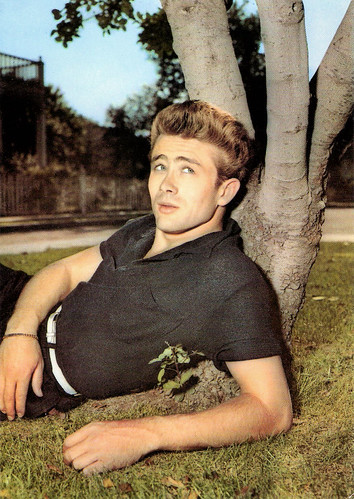
Italian postcard by Rotalfoto, Milano, no. 5.
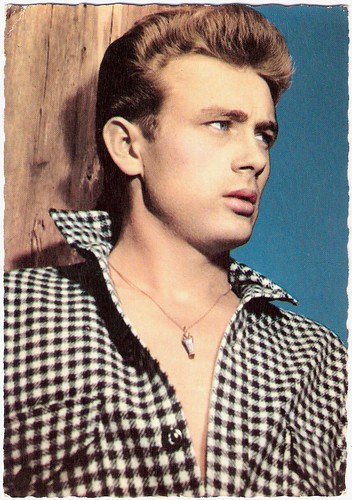
French postcard by E.D.U.G., no. 92. Photo: publicity still for East of Eden (Elia Kazan, 1955).

German postcard by Kolibri-Verlag G.m.b.H., no. 314. Photo: Warner Bros. Publicity still for The James Dean Story (Robert Altman, George W. George, 1957). The documentary The James Dean Story was undertaken soon after James Dean's death. It includes East of Eden (1955) outtakes, shots from the opening night of Giant (1956), and Dean's TV safe driving message. Directors Robert Altman and George W. George look at Dean's life through the use of still photographs with narration and interviews with many of the people involved in his short life. Interviewees include the aunt and uncle who raised him after his mother's death (when James was 9), his fraternal grandparents, a cab driver friend in New York City, and the owner of his favourite restaurant in Los Angeles. James's father, who was alive when the film was made, does not get a single mention. Altman later would direct Come Back to the 5 & Dime, Jimmy Dean, Jimmy Dean (Robert Altman, 1982) in which the Disciples of James Dean meet up on the anniversary of his death.
Sources: Hal Erickson (AllMovie), David Glagovsky (IMDb), Ed Stephan (IMDb), Daniel Bates (Daily Mail), Towleroad (now defunct), Wikipedia, and IMDb.
This post was last updated on 6 December 2023.

Italian postcard by Rotalfoto, Milano, no. 519. Photo: Richard Miller / Warner Bros. Publicity still for Giant (George Stevens, 1956).

Italian postcard by Rotalfoto, Milano, no. 522. Photo: Richard Miller / Warner Bros. Publicity still for Giant (George Stevens, 1956).

French postcard by Editions P.I., offered by Les Carbones Korès 'Carboplane', no. 18. Photo: AFEX, Wien (Vienna). Photo: publicity still for East of Eden (Elia Kazan, 1955).
Struggling to get jobs in Hollywood
James Byron Dean was born in 1931, in Marion, Indiana, the only child of Winton Dean and Mildred Marie Wilson. Six years after his father had left farming to become a dental technician, Dean and his family moved to Santa Monica, California. In 1938, his mother was suddenly struck with acute stomach pain and quickly began to lose weight. She died of uterine cancer when Dean was nine years old. Unable to care for his son, Dean's father sent him to live with his aunt and uncle, Ortense and Marcus Winslow, on their farm in Fairmount, Indiana, where he was raised in their Quaker household. Dean's overall performance in school was exceptional and he was a popular student. He played on the baseball and varsity basketball teams, studied drama, and competed in public speaking through the Indiana High School Forensic Association.
After graduating from Fairmount High School in May 1949, he moved back to California with his dog, Max, to live with his father and stepmother. He enrolled in Santa Monica College (SMC) and majored in pre-law. He transferred to UCLA for one semester and changed his major to drama, which resulted in estrangement from his father. While at UCLA, Dean was picked from a group of 350 actors to portray Malcolm in 'Macbeth'. At that time, he also began acting in James Whitmore's workshop. In January 1951, he dropped out of UCLA to pursue a full-time career as an actor.
Dean's first television appearance was in a Pepsi-Cola commercial. His first speaking part was as John the Beloved Disciple, in Hill Number One (1951), an Easter television special dramatising the Resurrection of Jesus. Dean subsequently obtained three walk-on roles in films: as a soldier in Samuel Fuller’s moody study of a platoon in the Korean War, Fixed Bayonets! (Samuel Fuller, 1951), a boxing cornerman in the Dean Martin and Jerry Lewis comedy Sailor Beware (Hal Walker, 1952), and a youth in the comedy Has Anybody Seen My Gal? (Douglas Sirk, 1952) with Rock Hudson.
While struggling to get jobs in Hollywood, Dean also worked as a parking lot attendant at CBS Studios. During that time, he met Rogers Brackett, a radio director for an advertising agency, who offered him professional help and guidance in his chosen career, as well as a place to stay. In July 1951, Dean appeared on Alias Jane Doe, which was produced by Brackett. In October 1951, Dean moved to New York City. There, he worked as a stunt tester for the game show Beat the Clock, but was subsequently fired for allegedly performing the tasks too quickly. He also appeared in episodes of several CBS television series like The Web, Studio One, and Lux Video Theatre, before gaining admission to the Actors Studio to study method acting under Lee Strasberg. There, he was classmates and close friends with Carroll Baker, alongside whom he would eventually star in Giant (George Stevens, 1956).
Dean's career picked up and he performed in further episodes of several early 1950s television. One early role, for the CBS series Omnibus in the episode Glory in the Flower (1953), saw Dean portraying the type of disaffected youth he would later portray in Rebel Without a Cause. In 1954, Dean had his breakthrough on Broadway in a play written by Augustus and Ruth Goetz and based on André Gide's book 'The Immoralist'. Louis Jourdan played Michel, a gay archaeologist who marries partly in the hope of curbing his homosexual instincts. He is unable to consummate the marriage so the pair travel from Normandy to Algeria for a honeymoon, hoping that will kindle some romance. The husband is seduced by Bachir, their Arab houseboy (James Dean), but this allows him to sleep with his wife (Geraldine Page), who falls pregnant. Positive reviews for Dean's role led to calls from Hollywood.

Dutch postcard by Uitg. Takken, Utrecht, no. 3685. Photo: Warner Bros. Dean photographed by Roy Schatt at Christmas 1954.

German postcard by Kolibri-Verlag G.m.b.H., no. 1983. Photo: Warner Bros.

German postcard by Kolibri-Verlag G.m.b.H., no. 2714. Photo: publicity still for Rebel Without a Cause (Nicholas Ray, 1955).
Angst-ridden protagonists and misunderstood outcasts
In 1954, James Dean was cast in the emotionally complex role of Cal Trask in East of Eden (Elia Kazan, 1955), an adaptation of John Steinbeck's 1952 novel East of Eden. The lengthy novel deals with the story of the Trask and Hamilton families throughout three generations, focusing especially on the lives of the latter two generations in Salinas Valley, California, from the mid-19th century through the 1910s.
In contrast to the book, the film script focused on the last portion of the story, predominantly with the character of Cal. Though he initially seems more aloof and emotionally troubled than his twin brother Aron (Richard Davalos), Cal is soon seen to be more worldly, business savvy, and even sagacious than their pious and constantly disapproving father (Raymond Massey) who seeks to invent a vegetable refrigeration process. Cal is bothered by the mystery of their supposedly dead mother, and discovers she is still alive and a brothel-keeping 'madam'; the part was played by actress Jo Van Fleet.
Much of Dean's performance in the film was unscripted, including his dance in the bean field and his foetal-like posturing while riding on top of a train boxcar (after searching out his mother in nearby Monterey). The most famous improvisation of the film occurs when Cal's father rejects his gift of $5,000, money Cal earned by speculating in beans before the US became involved in World War I. Instead of running away from his father as the script called for, Dean instinctively turned to Massey and in a gesture of extreme emotion, lunged forward and grabbed him in a full embrace, crying. Kazan kept this and Massey's shocked reaction in the film.
Wikipedia: “Dean's performance in the film foreshadowed his role as Jim Stark in Rebel Without A Cause. Both characters are angst-ridden protagonists and misunderstood outcasts, desperately craving approval from their fathers.”
In recognition of his performance in East of Eden, Dean was nominated posthumously for the 1956 Academy Awards as Best Actor in a Leading Role of 1955, the first official posthumous acting nomination in Academy Awards history. East of Eden was the only film starring Dean that he would see released in his lifetime.

British postcard in the Picturegoer Series, London, no. D 697. Photo: Warner. Publicity still for East of Eden (Elia Kazan, 1955).

British postcard in the Picturegoer Series, no. D 780. Photo: Warner Bros. Julie Harris and James Dean in East of Eden (Elia Kazan, 1955). Collection: Marlene Pilaete.

German postcard by Kunst und Bild, Berlin, no. V 370. Photo: Warner Bros. Publicity still for East of Eden (Elia Kazan, 1955).
Brooding red-jacketed teenager
James Dean quickly followed up his role in Eden with a starring role as the brooding red-jacketed teenager Jim Stark in Rebel Without a Cause (Nicholas Ray, 1955) with Sal Mineo and Natalie Wood. The film depicts the dilemma of a typical teenager of the time, who feels that no one, not even his peers, can understand him. The film scrupulously follows the classic theatrical disciplines, telling all within 24 hours.
Jim Stark was Dean’s true starring role and Rebel Without a Cause proved to be hugely popular among teenagers. The landmark juvenile-delinquent drama fixed James Dean’s image forever in American culture.
In his next film, Giant (George Stevens, 1956), Dean played a supporting role to Elizabeth Taylor and Rock Hudson. This was due to his desire to avoid being typecast as a rebellious teenager like Cal Trask or Jim Stark. In the film, he plays Jett Rink, a Texan ranch hand who strikes oil and becomes wealthy. His role was notable in that, to portray an older version of his character in the film's later scenes, Dean dyed his hair grey and shaved some of it off to give himself a receding hairline.
Giant would prove to be Dean's last film. At the end of the film, Dean is supposed to make a drunken speech at a banquet; this is nicknamed the 'Last Supper' because it was the last scene before his sudden death. Due to his desire to make the scene more realistic by actually being inebriated for the take, Dean mumbled so much that director George Stevens decided the scene had to be overdubbed.
This was done by Nick Adams, who had a small role in the film because Dean had died before the film was edited. Dean received his second posthumous Best Actor Academy Award nomination for his role in Giant at the 29th Academy Awards in 1957 for films released in 1956.

British postcard in the Picturegoer Series, London, no. D 769. Photo: Warner Bros. Publicity still for Rebel Without a Cause (Nicholas Ray, 1955).

British postcard in the Picturegoer Series, London, no. D 770. Photo: Warner Bros. Publicity still for Rebel Without a Cause (Nicholas Ray, 1955) with Sal Mineo.

British postcard in the Picturegoer Series, London, no. D 903. Photo: Warner Bros. Publicity still for Giant (George Stevens, 1956) with Elizabeth Taylor.

British postcard in the Picturegoer Series, no. D 905. Photo: Warner Bros. Carroll Baker and James Dean in Giant (William Wyler, 1958).
'The greatest male gay icon of all time'
Today, James Dean is often considered an icon because of his perceived experimental take on life, which included his ambivalent sexuality. Most of his so-called affairs with various starlets were made up by the Warner Brothers' public relations. Dean's best-remembered relationship was with young Italian actress Pier Angeli, whom he met while Angeli was shooting The Silver Chalice (Victor Saville, 1954) on an adjoining Warner lot, and with whom he exchanged items of jewellery as love tokens.
Angeli's Catholic mother disapproved of Dean. After finishing his role for East of Eden, he took a brief trip to New York in October 1954. While he was away, Angeli unexpectedly announced her engagement to Italian-American singer Vic Damone. The press was shocked and Dean expressed his irritation. Angeli married Damone the following month. Dean also dated Swiss actress Ursula Andress. She was seen with Dean in his sports car and was with him on the day he bought the car that he died in.
A Gay Times Readers' Awards cited him as 'the greatest male gay icon of all time' and other gay media also mention him as an icon. Dean’s ambiguous relationship with Sal Mineo in the angst-ridden Rebel Without A Cause has led many to speculate and view this golden-age film as years ahead of its time. When questioned about his sexual orientation, Dean is reported to have said, "No, I am not a homosexual. But I'm also not going to go through life with one hand tied behind my back." Dean, with time on his side during down times of filming, often frequented gay bars in mornings, afternoons and evenings in both Hollywood, Studio City and North Hollywood.
Dean and screenwriter and theatre student from UCLA, William Bast lived together as roommates for several years. Bast later became Dean's first biographer and said he and Dean ‘experimented’ sexually. Another biographer, journalist Joe Hyams suggests that any gay activity Dean might have been involved in appears to have been strictly "for trade", as a means of advancing his career. However, the ‘trade only’ notion is contradicted by Bast and other Dean biographers. Biographer Val Holley: “There's been quite an evolution in the thinking since Dean died in 1955, moving from ‘James Dean was straight’ to ‘Dean had sex with men but only to advance his career’ to ‘Dean had sex with women but only to advance his career.’
In 2016, a new gossipy biography was published, James Dean: Tomorrow Never Comes, by Darwin Porter and Danforth Prince. The authors claim Dean was in love with Marlon Brando and the two would have had a long sexual affair with S&M overtones. We probably may never know for certain if Dean identified as gay, straight, or bisexual, but, regardless, of what he’s come to represent he still resonates with many LGBTQ audiences. When questioned about Dean's sexuality by the openly gay journalist Kevin Sessums for POZ magazine, Elizabeth Taylor responded, "He hadn't made up his mind. He was only 24 when he died. But he was certainly fascinated by women. He flirted around. He and I … twinkled."

With Pier Angeli. German postcard by Kolibri-Verlag, Minden/Westf., no. 2346. Photo: Keystone.

Italian postcard by B.F.F. Edit., Firenze (Florence), no. 3435. Photo: Warner Bros. Publicity still for Giant (George Stevens, 1956).

Dutch postcard. Photo: Warner Bros.
A cult object of apparently timeless fascination
In 1954, James Dean became interested in developing an auto racing career. He purchased various vehicles after filming for East of Eden had concluded, including a Triumph Tiger T110 and a Porsche 356. Just before filming began on Rebel Without a Cause, he competed in his first professional event at the Palm Springs Road Races, which was held in Palm Springs, California on March 26–27, 1955. Dean achieved first place in the novice class and second place at the main event.
His racing continued in Bakersfield a month later, where he finished first in his class and third overall. Dean hoped to compete in the Indianapolis 500, but his busy schedule made it impossible. Dean's final race occurred in Santa Barbara on Memorial Day, 30 May 1955. He was unable to finish the competition due to a blown piston. His brief racing career was put on hold when Warner Brothers barred him from all racing during the production of Giant. Dean had finished shooting his scenes and the movie was in post-production when he decided to race again.
Dean was scheduled to compete at a racing event in Salinas, California on 30 September 1955. Accompanying the actor to the occasion was stunt coordinator Bill Hickman, Collier's photographer Sanford Roth, and Rolf Wütherich, the German mechanic from the Porsche factory who maintained Dean's Porsche 550 Spyder 'Little Bastard' car. Wütherich, who had encouraged Dean to drive the car from Los Angeles to Salinas to break it in, accompanied Dean in the Porsche. At 3:30 p.m. Dean was ticketed for speeding, as was Hickman who was following behind in another car.
As the group travelled to the event via U.S. Route 466, (currently SR 46) at approximately 5:15 p.m. a 1950 Ford Tudor was passing through an intersection while turning, ahead of the Porsche. Dean, unable to stop in time, slammed into the driver's side of the Ford resulting in Dean's car bouncing across the pavement onto the side of the highway. Dean's passenger, Wütherich, was thrown from the Porsche, while Dean was trapped in the car and sustained numerous fatal injuries, including a broken neck. The driver of the Ford, Donald Turnupseed, exited his damaged vehicle with minor injuries.
Dean was pronounced dead on arrival shortly after he arrived by ambulance at the Paso Robles War Memorial Hospital at 6:20 p.m. The Failure Analysis Associates later reconstructed and recreated all details of the accident and concluded that James Dean was travelling 55 to 56 mph when the fateful accident occurred, thereby proving he had not been speeding, as rumour had it. Ed Stephan at IMDb: “At age 24, James Dean was killed almost immediately from the impact of a broken neck. His very brief career, violent death and highly publicised funeral transformed him into a cult object of apparently timeless fascination.”

Italian postcard by Rotalfoto, Milano, no. 5.

French postcard by E.D.U.G., no. 92. Photo: publicity still for East of Eden (Elia Kazan, 1955).

German postcard by Kolibri-Verlag G.m.b.H., no. 314. Photo: Warner Bros. Publicity still for The James Dean Story (Robert Altman, George W. George, 1957). The documentary The James Dean Story was undertaken soon after James Dean's death. It includes East of Eden (1955) outtakes, shots from the opening night of Giant (1956), and Dean's TV safe driving message. Directors Robert Altman and George W. George look at Dean's life through the use of still photographs with narration and interviews with many of the people involved in his short life. Interviewees include the aunt and uncle who raised him after his mother's death (when James was 9), his fraternal grandparents, a cab driver friend in New York City, and the owner of his favourite restaurant in Los Angeles. James's father, who was alive when the film was made, does not get a single mention. Altman later would direct Come Back to the 5 & Dime, Jimmy Dean, Jimmy Dean (Robert Altman, 1982) in which the Disciples of James Dean meet up on the anniversary of his death.
Sources: Hal Erickson (AllMovie), David Glagovsky (IMDb), Ed Stephan (IMDb), Daniel Bates (Daily Mail), Towleroad (now defunct), Wikipedia, and IMDb.
This post was last updated on 6 December 2023.
No comments:
Post a Comment